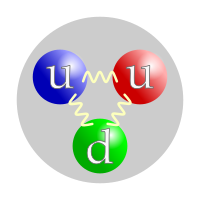
Photo from wikipedia
The relative stopping power (RSP) uncertainty is the largest contributor to the range uncertainty in proton therapy. The purpose of this work was to develop a systematic method that yields… Click to show full abstract
The relative stopping power (RSP) uncertainty is the largest contributor to the range uncertainty in proton therapy. The purpose of this work was to develop a systematic method that yields accurate and patient-specific RSPs by combining (1) pre-treatment x-ray CT and (2) daily proton radiography of the patient. The method was formulated as a penalized least squares optimization problem (argmin([Formula: see text])). The parameter A represents the cumulative path-length crossed by the proton in each material, separated by thresholding on the HU. The material RSPs (water equivalent thickness/physical thickness) are denoted by x. The parameter b is the list-mode proton radiography produced using Geant4 simulations. The problem was solved using a non-negative linear-solver with [Formula: see text]. A was computed by superposing proton trajectories calculated with a cubic or linear spline approach to the CT. The material's RSP assigned in Geant4 were used for reference while the clinical HU-RSP calibration curve was used for comparison. The Gammex RMI-467 phantom was first investigated. The standard deviation between the estimated material RSP and the calculated RSP is 0.45%. The robustness of the techniques was then assessed as a function of the number of projections and initial proton energy. Optimization with two initial projections yields precise RSP (⩽1.0%) for 330 MeV protons. 250 MeV protons have shown higher uncertainty (⩽2.0%) due to the loss of precision in the path estimate. Anthropomorphic phantoms of the head, pelvis, and lung were subsequently evaluated. Accurate RSP has been obtained for the head ([Formula: see text]), the lung ([Formula: see text]) and the pelvis ([Formula: see text]). The range precision has been optimized using the calibration curves obtained with the algorithm, yielding a mean [Formula: see text] difference to the reference of 0.11 ±0.09%, 0.28 ± 0.34% and [Formula: see text] in the same order. The solution's accuracy is limited by the assumed HU/RSP bijection, neglecting inherent degeneracy. The proposed formulation of the problem with prior knowledge x-ray CT demonstrates potential to increase the accuracy of present RSP estimates.
Journal Title: Physics in medicine and biology
Year Published: 2017
Link to full text (if available)
Share on Social Media: Sign Up to like & get
recommendations!